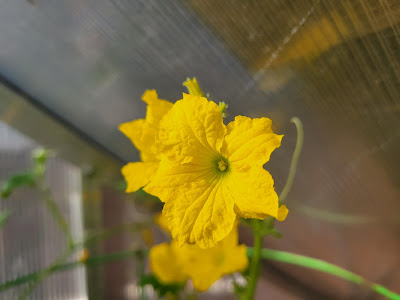In the fall of 2024, I had the opportunity to grow out the Carosello Tondo di Massafra in the greenhouse. I settled on growing out this variety due to my friend Giuseppe mentioning to me that he was not able to see much of a difference between the coloration patterns of the Massafra, in comparison to the coloration of the Massafrese.
My seed source for the fall Massafra growout was seed from Riccardo Larosa. As much of the Riccardo Larosa seed tends to be poor quality or old, I made sure to soak the seeds in a diluted solution of hydrogen peroxide and water before attempting to sprout them in a warm moist paper towel. Once the seeds sprouted, I transferred them into the hydroponic baskets in the greenhouse.
The plants grew quickly in the late summer and began putting on female flowers. That is when I noticed that the female flowers were hermaphrodites. This was new to me. Had my previous Tondo Massafra exhibited hermaphrodite flowers? I’m not sure. I may have to try growing them again to find out.
The Riccardo Larosa Tondo di Massafra grew as one would expect. The texture was not as fine as I would have preferred, but that is often the case with the fruit I produce from my greenhouse. It would seem that, while stress does not induce bitterness in melons, it does affect fruit quality and cause the fruit to produce seed earlier.
Overall, the Tondo Massafra that I grew in the greenhouse didn’t surprise me too much; except for the hermaphrodite traits exhibited by some of the flowers. I’ll have to keep an eye out for those traits the next time I grow this variety in the garden.



























































